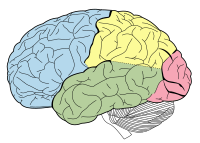
Photo from wikipedia
BACKGROUND Neuroanatomic locations of gliomas may influence clinical presentations, molecular profiles, and patients' prognoses. METHODS We investigated our institutional cancer registry to include patients with glioma over a 10-year period.… Click to show full abstract
BACKGROUND Neuroanatomic locations of gliomas may influence clinical presentations, molecular profiles, and patients' prognoses. METHODS We investigated our institutional cancer registry to include patients with glioma over a 10-year period. Statistical tests were used to compare demographic, genetic, and clinical characteristics among patients with gliomas in different locations. Survival analysis methods were then used to assess associations between location and overall survival in the full cohort, as well as in relevant subgroups. RESULTS 182 gliomas were identified. Of the tumours confined to a single lobe, there were 51 frontal (28.0%), 50 temporal (27.5%), 22 parietal (12.1%), and seven occipital tumours (3.8%) identified. Tumours affecting the temporal lobe were associated with reduced overall survival when compared to all other tumours (11 months vs. 13 months, log-rank p = 0.0068). In subgroup analyses, this result was significant for males [HR (95%CI) 2.05 (1.30, 3.24), p = 0.002], but not for females [HR (95%CI) 1.12 (0.65, 1.93), p = 0.691]. Out of 82 cases tested for IDH-1, 10 were mutated (5.5%). IDH-1 mutation was present in six frontal, two temporal, one thalamic, and one multifocal tumour. Out of 21 cases tested for 1p19q deletions, 12 were co-deleted, nine of which were frontal lobe tumours. MGMT methylation was assessed in 45 cases; 7/14 frontal tumours and 6/13 temporal tumours were methylated. CONCLUSION Our results support the hypothesis that the anatomical locations of gliomas influence patients' clinical courses. Temporal lobe tumours were associated with poorer survival, though this association appeared to be driven by these patients' more aggressive tumour profiles and higher risk baseline demographics. Independently, female patients who had temporal lobe tumours fared better than males. Molecular analysis was limited by the low prevalence of genetic testing in the study sample, highlighting the importance of capturing this information for all gliomas. IMPORTANCE OF THIS STUDY The specific neuroanatomic location of tumours in the brain is thought to be predictive of treatment options and overall prognosis. Despite evidence for the clinical significance of this information, there is relatively little information available regarding the incidence and prevalence of tumours in the different anatomical regions of the brain. This study has more fully characterised tumour prevalence in different regions of the brain. Additionally, we have analysed how this information may affect tumours' molecular characteristics, treatment options offered to patients, and patients' overall survival. This information will be informative both in the clinical setting and in directing future research.
Journal Title: Neurologia i neurochirurgia polska
Year Published: 2020
Link to full text (if available)
Share on Social Media: Sign Up to like & get
recommendations!